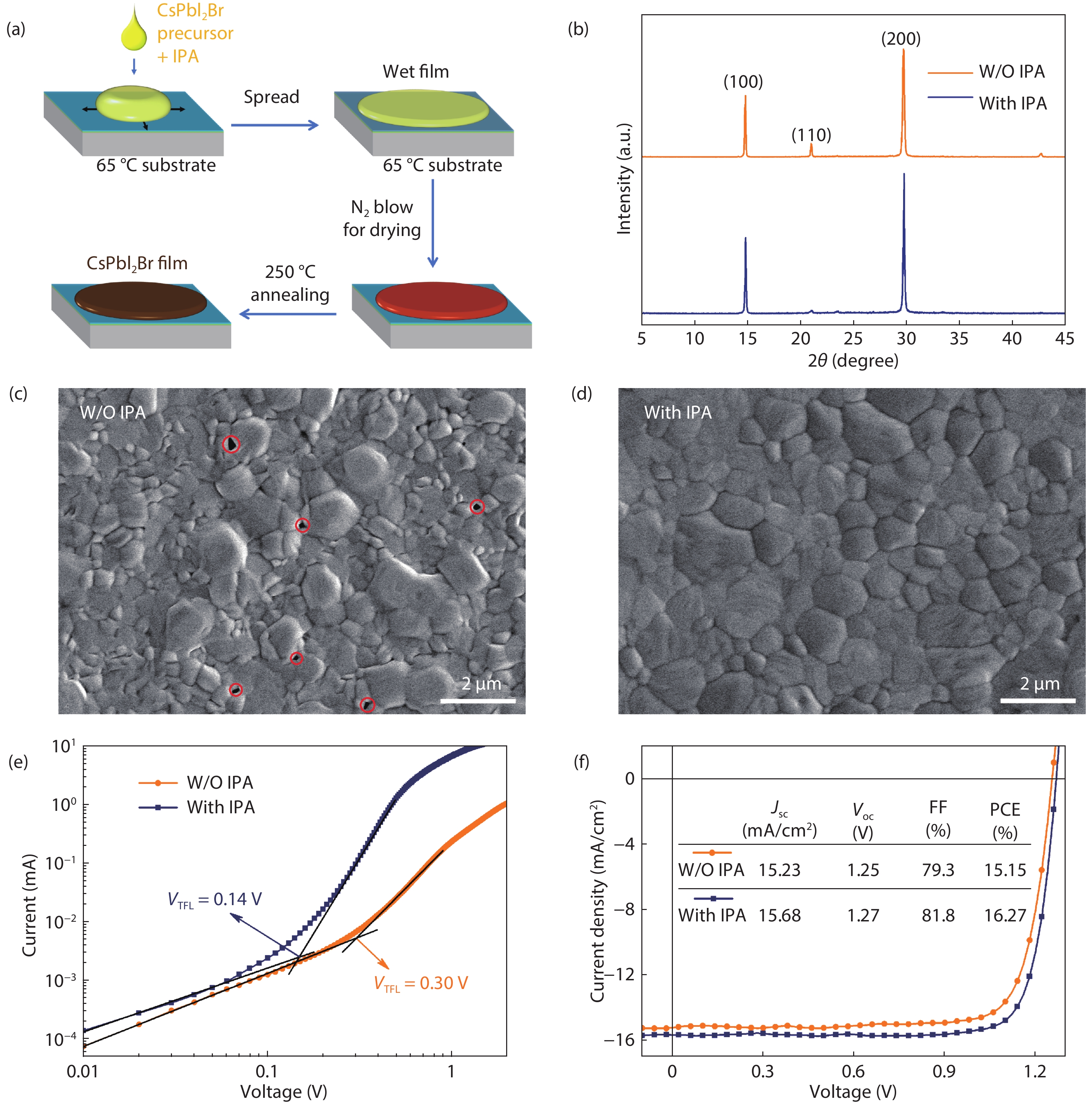| Citation: |
Hanrui Xiao, Chuantian Zuo, Fangyang Liu, Liming Ding. Drop-coating produces efficient CsPbI2Br solar cells[J]. Journal of Semiconductors, 2021, 42(5): 050502. doi: 10.1088/1674-4926/42/5/050502
****
H R Xiao, C T Zuo, F Y Liu, L M Ding, Drop-coating produces efficient CsPbI2Br solar cells[J]. J. Semicond., 2021, 42(5): 050502. doi: 10.1088/1674-4926/42/5/050502.
|
Drop-coating produces efficient CsPbI2Br solar cells
DOI: 10.1088/1674-4926/42/5/050502
More Information
-
References
[1] Sutton R J, Eperon G E, Miranda L, et al. Bandgap-tunable cesium lead halide perovskites with high thermal stability for efficient solar cells. Adv Energy Mater, 2016, 6, 1502458 doi: 10.1002/aenm.201502458[2] Eperon G E, Stranks S D, Menelaou C, et al. Formamidinium lead trihalide: A broadly tunable perovskite for efficient planar heterojunction solar cells. Energy Environ Sci, 2014, 7, 982 doi: 10.1039/c3ee43822h[3] Wang Y, Dar M I, Ono L K, et al. Thermodynamically stabilized β-CsPbI3-based perovskite solar cells with efficiencies > 18%. Science, 2019, 365, 591 doi: 10.1126/science.aav8680[4] Zhang J, Hodes G, Jin Z, et al. All-inorganic CsPbX3 perovskite solar cells: Progress and prospects. Angew Chem Int Ed, 2019, 58, 15596 doi: 10.1002/anie.201901081[5] Yoon S M, Min H, Kim J B, et al. Surface engineering of ambient-air-processed cesium lead triiodide layers for efficient solar cells. Joule, 2021, 5, 183 doi: 10.1016/j.joule.2020.11.020[6] Sutton R J, Filip M R, Haghighirad A A, et al. Cubic or orthorhombic? Revealing the crystal structure of metastable black-phase CsPbI3 by theory and experiment. ACS Energy Lett, 2018, 3, 1787 doi: 10.1021/acsenergylett.8b00672[7] Yao H, Zhao J, Li Z, et al. Research and progress of black metastable phase CsPbI3 solar cells. Mater Chem Front, 2021, 5, 1221 doi: 10.1039/D0QM00756K[8] Li Z, Yang M, Park J S, et al. Stabilizing perovskite structures by tuning tolerance factor: Formation of formamidinium and cesium lead iodide solid-state alloys. Chem Mater, 2016, 28, 284 doi: 10.1021/acs.chemmater.5b04107[9] Fang Z, Meng X, Zuo C, et al. Interface engineering gifts CsPbI2.25Br0.75 solar cells high performance. Sci Bull, 2019, 64, 1743 doi: 10.1016/j.scib.2019.09.023[10] Ho-Baillie A, Zhang M, Lau C F J, et al. Untapped potentials of inorganic metal halide perovskite solar cells. Joule, 2019, 3, 938 doi: 10.1016/j.joule.2019.02.002[11] Fang Z, Liu L, Zhang Z, et al. CsPbI2.25Br0.75 solar cells with 15.9% efficiency. Sci Bull, 2019, 64, 507 doi: 10.1016/j.scib.2019.04.013[12] Jia X, Zuo C, Tao S, et al. CsPb(IxBr1−x)3 solar cells. Sci Bull, 2019, 64, 1532 doi: 10.1016/j.scib.2019.08.017[13] Liu L, Xiao Z, Zuo C, et al. Inorganic perovskite/organic tandem solar cells with efficiency over 20%. J Semicond, 2021, 42, 020501 doi: 10.1088/1674-4926/42/2/020501[14] Zhang Z, Li J, Fang Z, et al. Adjusting energy level alignment between HTL and CsPbI2Br to improve solar cell efficiency. J Semicond, 2021, 42, 030501 doi: 10.1088/1674-4926/42/2/030501[15] Wang P, Wang H, Mao Y, et al. Organic ligands armored ZnO enhances efficiency and stability of CsPbI2Br perovskite solar cells. Adv Sci, 2020, 7, 2000421 doi: 10.1002/advs.202000421[16] Patil J V, Mali S S, Hong C K. A-site rubidium cation-incorporated CsPbI2Br all-inorganic perovskite solar cells exceeding 17% efficiency. Sol RRL, 2020, 4, 2000164 doi: 10.1002/solr.202000164[17] Chen W, Chen H, Xu G, et al. Precise control of crystal growth for highly efficient CsPbI2Br perovskite solar cells. Joule, 2019, 3, 191 doi: 10.1016/j.joule.2018.10.011[18] Lin Z Q, Qiao H W, Zhou Z R, et al. Water assisted formation of highly oriented CsPbI2Br perovskite films with the solar cell efficiency exceeding 16%. J Mater Chem A, 2020, 8, 17670 doi: 10.1039/D0TA05118G[19] Wang A, Deng X, Wang J, et al. Ionic liquid reducing energy loss and stabilizing CsPbI2Br solar cells. Nano Energy, 2021, 81, 105631 doi: 10.1016/j.nanoen.2020.105631[20] Han Y, Zhao H, Duan C, et al. Controlled n-doping in air-stable CsPbI2Br perovskite solar cells with a record efficiency of 16.79%. Adv Funct Mater, 2020, 30, 1909972 doi: 10.1002/adfm.201909972[21] Shang Y, Fang Z, Hu W, et al. Efficient and photostable CsPbI2Br solar cells realized by adding PMMA. J Semicond, 2021, 42, 050501 doi: 10.1088/1674-4926/42/2/050501[22] Mali S S, Patil J V, Shinde P S, et al. Fully air-processed dynamic hot-air-assisted M:CsPbI2Br (M: Eu2+, In3+) for stable inorganic perovskite solar cells. Matter, 2021, 4, 635 doi: 10.1016/j.matt.2020.11.008[23] He J, Liu J, Hou Y, et al. Surface chelation of cesium halide perovskite by dithiocarbamate for efficient and stable solar cells. Nat Commun, 2020, 11, 4237 doi: 10.1038/s41467-020-18015-5[24] Fan Y, Fang J, Chang X, et al. Scalable ambient fabrication of high-performance CsPbI2Br solar cells. Joule, 2019, 3, 2485 doi: 10.1016/j.joule.2019.07.015[25] Zuo C, Scully A D, Tan W L, et al. Crystallisation control of drop-cast quasi-2D/3D perovskite layers for efficient solar cells. Commun Mater, 2020, 1, 33 doi: 10.1038/s43246-020-0036-z[26] Zuo C, Scully A D, Vak D, et al. Self-assembled 2D perovskite layers for efficient printable solar cells. Adv Energy Mater, 2019, 9, 1803258 doi: 10.1002/aenm.201803258[27] Zuo C, Ding L. Drop-casting enables making efficient perovskite solar cells under high humidity. Angew Chem Int Ed, 2021 doi: 10.1002/anie.202101868[28] Xu G, Xue R, Chen W, et al. New strategy for two-step sequential deposition: Incorporation of hydrophilic fullerene in second precursor for high-performance p-i-n planar perovskite solar cells. Adv Energy Mater, 2018, 8, 1703054 doi: 10.1002/aenm.201703054[29] Bi D, Yi C, Luo J, et al. Polymer-templated nucleation and crystal growth of perovskite films for solar cells with efficiency greater than 21%. Nat Energy, 2016, 1, 16142 doi: 10.1038/nenergy.2016.142[30] Tian J, Wang J, Xue Q, et al. Composition engineering of all-inorganic perovskite film for efficient and operationally stable solar cells. Adv Funct Mater, 2020, 30, 2001764 doi: 10.1002/adfm.202001764[31] Li G, Ching K L, Ho J Y L, et al. Identifying the optimum morphology in high-performance perovskite solar cells. Adv Energy Mater, 2015, 5, 1401775 doi: 10.1002/aenm.201401775[32] Eperon G E, Burlakov V M, Docampo P, et al. Morphological control for high performance, solution-processed planar heterojunction perovskite solar cells. Adv Funct Mater, 2014, 24, 151 doi: 10.1002/adfm.201302090 -
Supplements
 21030018suppl.pdf
21030018suppl.pdf

-
Proportional views






 DownLoad:
DownLoad:
















